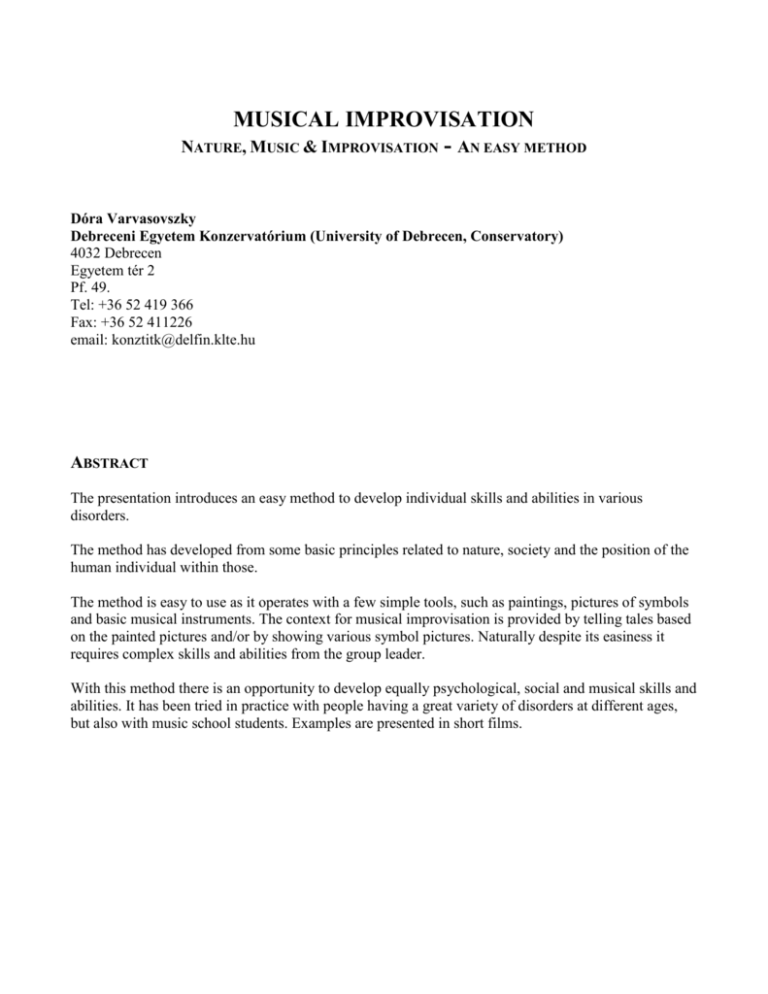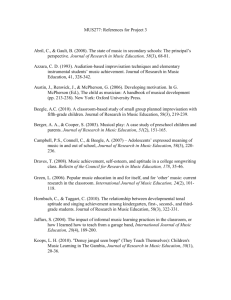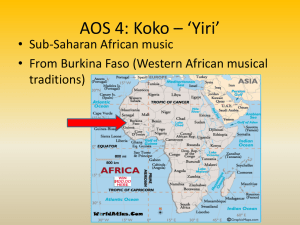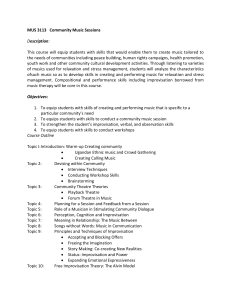MUSICAL IMPROVISATION Nature, Music & Improvisation
advertisement

MUSICAL IMPROVISATION NATURE, MUSIC & IMPROVISATION - AN EASY METHOD Dóra Varvasovszky Debreceni Egyetem Konzervatórium (University of Debrecen, Conservatory) 4032 Debrecen Egyetem tér 2 Pf. 49. Tel: +36 52 419 366 Fax: +36 52 411226 email: konztitk@delfin.klte.hu ABSTRACT The presentation introduces an easy method to develop individual skills and abilities in various disorders. The method has developed from some basic principles related to nature, society and the position of the human individual within those. The method is easy to use as it operates with a few simple tools, such as paintings, pictures of symbols and basic musical instruments. The context for musical improvisation is provided by telling tales based on the painted pictures and/or by showing various symbol pictures. Naturally despite its easiness it requires complex skills and abilities from the group leader. With this method there is an opportunity to develop equally psychological, social and musical skills and abilities. It has been tried in practice with people having a great variety of disorders at different ages, but also with music school students. Examples are presented in short films. MUSIC IMPROVISATION AN EASY METHOD by Dora Varvasovszky Velsz Presentation summary INTRODUCTION The presentation aims to introduce an easy music therapy method to develop individual skills and abilities in various disorders, assisting and leading to treatment (1, 2). In a broader sense assisting individuals towards expressing themselves, being able to experience joy, interact with others, turn from daily matters towards the bigger picture and the beauty of nature, and improving manual skills are treatment themselves. Life itself, but also even a day is full of unexpected situations and events. These need spontaneous response, “improvisation”. Playing with music instruments improvisation skills and abilities can be tested and developed helping to be more prepared for life situations. The method has developed from the following themes (Figure 1): (a) A human individual is a creature of nature, however (b) the natural context of individual existence is within society, societal groups, responses and interactions. Hence (c) disorders can be interpreted and translated in this context relative to societal norms and actions. (d) Symbols help to establish the link between nature and society for the individual. (e) Symbols can be translated through and by music, instrumental musical improvisation. (f) Via musical improvisation the reaction to the environment (also societal) and interaction with the group is manifested. In this way options for the individual to react, interact and develop are enhanced by a different quality: music. Figure 1 NATURE SYMBOLS MUSIC INDIVIDUAL SOCIETY There are several examples among music therapists how and why they turn towards nature in their approaches. Paolo J. Knill in his autobiography remembers how often he heard from his father in his carpentry workshop saying, that he would not cut out a knot from the wood as that could have had been considered a bud (3). This is a nice example how between nature and art a link can be drawn. Archetypes described by Jung are classic examples from the psychology literature which bind nature and human soul. Nature helps to understand how life is conceived, how it evolves and goes by. The child as well as the adult, the sick, the disabled as well as the healthy can gain examples from nature to understand his/her own position and context in life. People can be helped to find their identity and role 2 in the world when similarities are drawn between their situation and nature phenomena. These are or can be reflected via art, such as music. Reflecting upon nature phenomena via music leads to selfacceptance, self-recognition, eventually making individuals more happy and balanced, able to cope. Perhaps the most tangible direct reflection on nature within music can be found in folk music. Symbols, themes in folk songs link humans to basic nature elements, such as the sun, water, fire, blossoming and harvest. In the land of Kodaly folk songs are an inherent part of musical education. Music therapy can naturally draw on the richness but at the same time simplicity and symbolic language of folk music and art. Musical instruments themselves are symbols. The shape, sound and tone of an instrument itself, but also how the instrument fits with the human body have symbolic meaning. An example for the latter is that “hugging”, holding an instrument has a protective meaning for the playing individual (4). Music, rather sound making via improvisation in its broader sense, provides a unique form of communication with the potential to link the individual with his most spontaneous emotional level, opening door to archetypes. Also music improvisation provide a unique tool to establish the link with and reflect upon the individual’s surrounding environment. In music improvisation the tempo, volume, modality, length of phrases and rhythm arise from the individual’s position and also reflect upon his link to the group. As G. Orff mentions not only the previous musical qualities but also the feel of musical instruments have importance for therapy, such as the smoothness, warmth, weight and vibration. SHORT SUMMARY OF THE IMPROVISATION METHOD The method is easy as it operates with a few simple tools, such as paintings, pictures of symbols and basic percussion musical instruments (Figure 2). The context for musical improvisation is provided by telling tales using the painted pictures and/or by showing various symbol pictures. There are altogether five paintings with basic nature themes, such as sunshine, flowers, lakeside, fire and wood. There are also simplified drawings considered as symbols, which are also “nature archetypes”. The drawings and the paintings have been made with the intention to draw on nature but also provide sufficiently broad stimulus by which there is a chance that all musical elements and qualities can manifest in the improvisation process (melody, rhythm, pitch, volume, tone, scale, chord). The paintings and the symbols can be used separately on their own or together to initiate the improvisation process. Musical instruments used in the improvisation method include percussion, stringed and wind instruments. Using categories applied by van Der Meer, they are as follows: idiophone instruments: castanets, small cymbal, triangle, xylophone, handbell, claves; chordophone instruments: citera; membranophone instruments: drum, conga, bongo; aerophone instruments: pipe, flute. It has to be mentioned that in practice both a broader and a narrower range can be applicable depending on availability. Although a too wide choice of instruments may lead to unnecessary tension, while a too narrow choice limits their expression. Generally it is suggested that instruments are available in all the 3 main categories listed above. Experience shows that participants also like to use self-made instruments (e.g.a metal can filled with seeds and wrapped in paper). In the oral presentation the method is shown in practice on video presentation. Here just a few examples are mentioned. The picture of sunrise (Figure 2) with the tree in the front is most often translated into music by the following instruments: castanets, drum, triangle, cymbal, claves and bell, similarly to the three symbols presented. The triangle’s metallic tone, the three sides represent light emitting in all directions. The player of the triangle can gain the feeling that light can be spread taken around to any direction. The structure of the little metal balls on the handbell reflect order but also playfulness. Their tone and vibration resemble the tone of baby rattles. The first successful sound making activity of a human being with it baby hands in our culture happens most often with the rattle. The shape and colour of the bright sunshine most often is represented by cymbals in the improvisation. Other paintings, such as the picture of the sun and the flowers in practice are linked to metalophone and chordophone instruments, while painting of the lakeside and the wood to wooden and membranophone instruments. The colours on the paintings also link to musical qualities, such as warm colours to the sense of vibration. The video presentation provides more practical details and its actual operation. With this method there is an opportunity to develop equally psychological, social and musical skills and abilities. Figure 2 – Process: paintings, symbols and instruments THE METHOD IN PRACTICE This easy improvisation method has developed from many years of previous work experience in various care centres for disabled children. The simplicity but still wide outreach of the method to 4 various disturbances via musical improvisation makes it relatively easy to use in different contexts. It has to be mentioned though that the group leader must have psychological and also strong musical background with improvisation skills and practice. The improvisation method has been tried in practice with people having a great variety of disorders at different ages, but also with music school students. The experience from music therapy applicable among disabled individuals showed options for development in the following areas: communication skills and abilities, expression of joy and various experiences, body movements, coordination, manual skills and abilities, creativity. In the therapeutic process the choice of musical instrument already has a huge importance. This is maybe even more so with disabled individuals. Joseph, for example, a 35 year old man in the care centre for disabled at Nyiregyhaza insisted on handbells. It suggests that childhood life is still very dominant in his mental existence. Marian, age 25, was the oldest among three sisters. She was willing to take only the “C” one string citera from the various one string citeras. She eagerly took the role of conductor in the group improvisation – being the oldest sister, leading to joy and satisfaction. At home, however, she could not fulfil her oldest sister role of course because of her disturbance. Stephan, age 20, has been talking constantly at home and also in the care centre to the extent leading to impatience among those surrounding him. No wonder he has chosen carved wooden temple blocks (as we call them “frogs”) available at the time among the musical instruments. He was keen to participate and eventually was conducting the group with his mouth shaped instruments, also encouraging his carer to play louder. The instrument took over the role of speech, making his experience more colourful. It also helped people in his environment to tolerate him better. With music school children themes of the paintings can also be verbalised. Improvisation can be initiated also by words. Here the focus is naturally less on disorders, although hidden disturbances can also manifest. The aim is more on providing a context to develop musical skills and abilities. It has been already mentioned that instruments themselves have symbolic meaning for individuals. Using the improvisation method may also help children to switch to the right instrument before getting more advanced in their music education. Potentially the method can also be used in rehabilitation. It has already been tried in practice with patients with malignant neoplasm after operation. They are particularly keen to turn towards nature, seek peace and beauty, more ready to apply fine, warm, quiet, vibrating tunes turning more often to chordophone instruments, handbells and triangle. They like to repeat themselves in the music improvisation exercise which as they say “ strengthens” themselves. They are also generally more ready to play solo. They particularly enjoy being faced with options and the opportunity to take initiatives, but also being very considerate with other group members. In summary experience so far shows that this easy improvisation method helps to learn about the personality, develop missing or disturbed skills and abilities, condition reflexes, self-awareness, relate to other and generally operate better in “society”. 5 The German adaptation of the method would not have had been possible without the enormous help of Dr. phil. Hiltraud Reckmann. References (1) (2) (3) (4) Varvasovszkyné Velsz Dóra (1998): Zeneterápia és gyógypedagógia súlyosan és halmozottan sérültek intézményeiben (Music therapy and … in institutions for people with serious and multiple disorders); Debrecen. Varvasovszky-Velsz Dóra (2002): Musikterapie und heilpadagogik in Ungarn - Erkentnisse und Ergebnisse; In: Rheinland Pfalz: Möglichkeiten musikalischer Förderung bei (schwerst) behinderten Kindern und Jugendlichen; PZ-Information 3/2: pp: 1-64. Knill, Paolo J. (1987): Wissenschaftliche Betrachtungen zur Musiktherapie unter ethischen gesichtpunkten. Dokumentation der Fachtagung Musiktherapie des Musica-Kongresses Hamburg; Lilienthal, Band p:43. Decker Voigt, Hans-Helmut (1991): Aus der Seele gespielt; Munchen, pp: 255-262. 6







